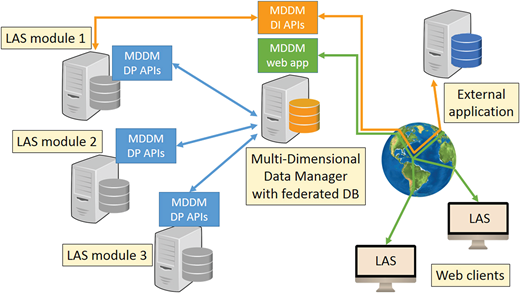Difference between revisions of "Template:Article of the week"
Shawndouglas (talk | contribs) (Updated article of the week text) |
Shawndouglas (talk | contribs) (Updated article of the week text) |
||
| Line 1: | Line 1: | ||
<div style="float: left; margin: 0.5em 0.9em 0.4em 0em;">[[File: | <div style="float: left; margin: 0.5em 0.9em 0.4em 0em;">[[File:Fig1 Grand Database2019 2019.png|240px]]</div> | ||
'''"[[Journal: | '''"[[Journal:One tool to find them all: A case of data integration and querying in a distributed LIMS platform|One tool to find them all: A case of data integration and querying in a distributed LIMS platform]]"''' | ||
In recent years, [[laboratory information management system]]s (LIMS) have been growing from mere inventory systems into increasingly comprehensive software platforms, spanning functionalities as diverse as data search, annotation, and [[Data analysis|analysis]]. In 2011, our institution started a LIMS project named the Laboratory Assistant Suite with the purpose of assisting researchers throughout all of their [[laboratory]] activities, providing graphical tools to support decision-making tasks and building complex analyses on integrated data. The modular architecture of the system exploits multiple databases with different technologies. To provide an efficient and easy tool for retrieving information of interest, we developed the Multi-Dimensional Data Manager (MDDM). By means of intuitive interfaces, scientists can execute complex queries without any knowledge of query languages or database structures, and easily integrate heterogeneous data stored in multiple databases. ('''[[Journal:One tool to find them all: A case of data integration and querying in a distributed LIMS platform|Full article...]]''')<br /> | |||
<br /> | <br /> | ||
''Recently featured'': | ''Recently featured'': | ||
: ▪ [[Journal:What is the "source" of open-source hardware?|What is the "source" of open-source hardware?]] | |||
: ▪ [[Journal:From command-line bioinformatics to bioGUI|From command-line bioinformatics to bioGUI]] | : ▪ [[Journal:From command-line bioinformatics to bioGUI|From command-line bioinformatics to bioGUI]] | ||
: ▪ [[Journal:ChromaWizard: An open-source image analysis software for multicolor fluorescence in situ hybridization analysis|ChromaWizard: An open-source image analysis software for multicolor fluorescence in situ hybridization analysis]] | : ▪ [[Journal:ChromaWizard: An open-source image analysis software for multicolor fluorescence in situ hybridization analysis|ChromaWizard: An open-source image analysis software for multicolor fluorescence in situ hybridization analysis]] | ||
Revision as of 16:18, 16 March 2020
"One tool to find them all: A case of data integration and querying in a distributed LIMS platform"
In recent years, laboratory information management systems (LIMS) have been growing from mere inventory systems into increasingly comprehensive software platforms, spanning functionalities as diverse as data search, annotation, and analysis. In 2011, our institution started a LIMS project named the Laboratory Assistant Suite with the purpose of assisting researchers throughout all of their laboratory activities, providing graphical tools to support decision-making tasks and building complex analyses on integrated data. The modular architecture of the system exploits multiple databases with different technologies. To provide an efficient and easy tool for retrieving information of interest, we developed the Multi-Dimensional Data Manager (MDDM). By means of intuitive interfaces, scientists can execute complex queries without any knowledge of query languages or database structures, and easily integrate heterogeneous data stored in multiple databases. (Full article...)
Recently featured:










